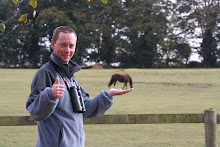Today we were out on the dry plains weather Lleida in search of bustards and sandgrouse.
First stop were the large arable fields around the village of Bujaraloz for the great bustards. It didn't take long before we picked up 3 in the roadside fields. A slow drive around the area produced a total of 14, including 7 together, although it was a bit early for them to be displaying yet.
Next stop was a large salt lake. The area used to produce salt but is now derelict. The ruins did produce our first lesser kestrel of the trip and the fields were full of larks. The highlight was a big group of common cranes moving north over the area.
We had a drive round some of the muddy tracks looking for little bustards but with no luck.
A quick stop to look for the great bustards only produced 4 but the light was better showing off their colour well.
We moved back east to spend the afternoon around the Los Monegros. This is a good area for raptors and sandgrouse.
While looking for a good site to watch for raptors we had already seen a couple of ringtail hen harriers and a nice group of 75 feeding chough.
There are tracks all over the plateau so actually finding any birds is a bit of a lottery which made finding our 'own' little bustard special. A little further up the road we picked up 15 pin tailed sandgrouse very close to the car but unfortunately they flushed into the next field before we could stop. As we got to the next field we fussed some more sandgrouse but these were black bellied!! Thankfully they flew a short distance and joined the pin tailed. 17 pin tailed and 15 black bellied together.
We spent a couple of hours at the edge of the plateau looking for raptors. It had been good, 2 golden eagle, griffon vultures and red kites when I picked up what I thought was a booted eagle.
When I saw the bird with one of the golden eagles i realised it wasn't a booted but something bigger and much better. The bird didn't seem to be doing much. It circled around the same area for 10mins before slowly heading east giving great views. I tried hard to get some phonescoped pics but couldn't. The only thing in the book that fitted was Spanish imperial eagle but it seemed too out of range!
We had another look at the little bustard, toured around some more tracks finding a hoopoe and another 11 black bellied sandgrouse before heading back to the hotel.
After an Internet search and a chat with Steve West, I am happy with the id of my eagle. Despite only seeing one in the area in over 20 years, Steve said there has been a small number seen here in the last 10 years. I can't believe I found and identified such a rare bird today.
Most definitely the bird of the trip!




















































